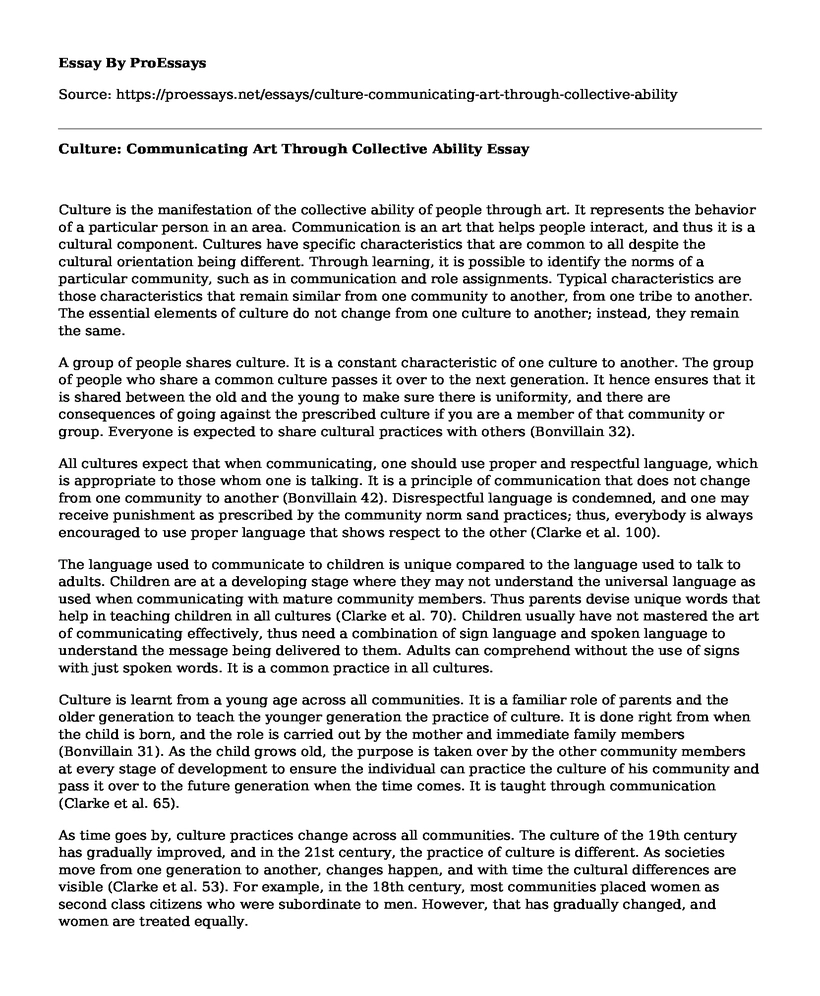Culture is the manifestation of the collective ability of people through art. It represents the behavior of a particular person in an area. Communication is an art that helps people interact, and thus it is a cultural component. Cultures have specific characteristics that are common to all despite the cultural orientation being different. Through learning, it is possible to identify the norms of a particular community, such as in communication and role assignments. Typical characteristics are those characteristics that remain similar from one community to another, from one tribe to another. The essential elements of culture do not change from one culture to another; instead, they remain the same.
A group of people shares culture. It is a constant characteristic of one culture to another. The group of people who share a common culture passes it over to the next generation. It hence ensures that it is shared between the old and the young to make sure there is uniformity, and there are consequences of going against the prescribed culture if you are a member of that community or group. Everyone is expected to share cultural practices with others (Bonvillain 32).
All cultures expect that when communicating, one should use proper and respectful language, which is appropriate to those whom one is talking. It is a principle of communication that does not change from one community to another (Bonvillain 42). Disrespectful language is condemned, and one may receive punishment as prescribed by the community norm sand practices; thus, everybody is always encouraged to use proper language that shows respect to the other (Clarke et al. 100).
The language used to communicate to children is unique compared to the language used to talk to adults. Children are at a developing stage where they may not understand the universal language as used when communicating with mature community members. Thus parents devise unique words that help in teaching children in all cultures (Clarke et al. 70). Children usually have not mastered the art of communicating effectively, thus need a combination of sign language and spoken language to understand the message being delivered to them. Adults can comprehend without the use of signs with just spoken words. It is a common practice in all cultures.
Culture is learnt from a young age across all communities. It is a familiar role of parents and the older generation to teach the younger generation the practice of culture. It is done right from when the child is born, and the role is carried out by the mother and immediate family members (Bonvillain 31). As the child grows old, the purpose is taken over by the other community members at every stage of development to ensure the individual can practice the culture of his community and pass it over to the future generation when the time comes. It is taught through communication (Clarke et al. 65).
As time goes by, culture practices change across all communities. The culture of the 19th century has gradually improved, and in the 21st century, the practice of culture is different. As societies move from one generation to another, changes happen, and with time the cultural differences are visible (Clarke et al. 53). For example, in the 18th century, most communities placed women as second class citizens who were subordinate to men. However, that has gradually changed, and women are treated equally.
Culture is essential for every community, as it gives community members a sense of identity. Rituals and communication languages are taught through culture. From a young age, there are cultural rituals that are conducted by the community; leaders that have culturally been assigned those roles to do ritual practices (Bonvillain 22). It is common across all cultures to have cultural leadership roles that observe the ritual and learning process within the culture, thus helping in making it an essential part of the community.
All cultures incorporate signs and symbols that carry with them unique meaning. The signs and symbols impact on all forms of communication across cultures and determine the kind of message and who is received by the audience (Clarke et al. 50). For example, when talking about the culture, the audience is likely to believe the person who gives a talk while wearing traditional regalia as opposed to a speaker in a suit talking about culture. Across all cultures, the signs and symbols determine the kind of message received and how it is received. They also help emphasize power in particular (Bonvillain 32).
Culture is an essential tool in communication. Every speaker must understand the cultural orientation of his audience when planning a talk. The uniqueness of culture is universal in all cultures, which brings out the beauty of humanity. The common characteristics of culture show that human beings are social beings who get a sense of attachment from culture. All cultures have the typical features mentioned above. It has impact on communication within communities and how effective delivery of a message should be done. The characteristics show there are unity inhuman beings, and behavior is the same despite the cultural orientation difference. Rules of interaction are the same. Works cited
Bonvillain, Nancy. Language, culture, and communication: The meaning of messages. Rowman & Littlefield, 2019.Clarke, John, et al. "Subcultures, cultures and class." Cultural Criminology. Routledge, 2017. 47-116.
Cite this page
Culture: Communicating Art Through Collective Ability. (2023, May 30). Retrieved from https://proessays.net/essays/culture-communicating-art-through-collective-ability
If you are the original author of this essay and no longer wish to have it published on the ProEssays website, please click below to request its removal:
- Urban Heat Islands
- Research Paper on Noise Pollution: Reducing its Negative Impacts
- Research Paper on Collecting Data in Statistics: Primary vs Secondary Methods
- Global Warming: Industrial Progress and its Impact on Climate Change - Essay Sample
- Essay Example on Health Care Safety: Essential For Quality Service Delivery & Profitability
- Essay Sample on Children & Police
- Calvino's, a Plunge Into Real Estate - Essay Sample







